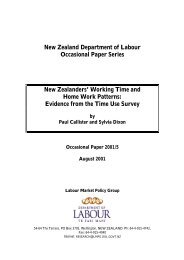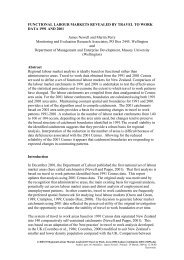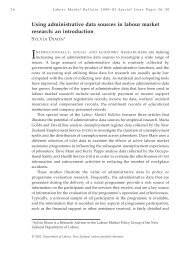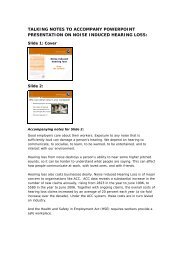Potential Output: Concepts and Measurement - Department of Labour
Potential Output: Concepts and Measurement - Department of Labour
Potential Output: Concepts and Measurement - Department of Labour
Create successful ePaper yourself
Turn your PDF publications into a flip-book with our unique Google optimized e-Paper software.
Darren Gibbs 87<br />
The HP filter is derived by minimising the sum <strong>of</strong> the squared deviations <strong>of</strong><br />
a variable (in this case, output), Q t<br />
, from its trend τ, subject to a smoothness<br />
constraint, λ, that penalises squared variations in the growth <strong>of</strong> the trend series.<br />
That is, the HP filter is calculated to minimise:<br />
T<br />
T−1<br />
QHP =<br />
∑ t − τ t + λ ∑<br />
τ t − τ − τ t − τ t<br />
t=<br />
1<br />
t=<br />
2<br />
[ + 1 1 −1<br />
]<br />
2<br />
( Q ) ( ) ( )<br />
Thus, the calculated HP trend series is a function <strong>of</strong> the smoothness constraint,<br />
<strong>and</strong> <strong>of</strong> both past <strong>and</strong> future values <strong>of</strong> output. The user can determine the<br />
smoothness in the trend series by choosing an appropriate value for the<br />
smoothness parameter. Higher values <strong>of</strong> λ imply a larger weight on the<br />
smoothness <strong>of</strong> the series, so that in the limit, as λ becomes arbitrarily large, the<br />
trend series will converge on a linear time trend. As Laxton <strong>and</strong> Tetlow note, this<br />
would be consistent with an extreme Keynesian model in which supply shocks<br />
are deterministic, <strong>and</strong> variations in output come almost entirely from dem<strong>and</strong><br />
shocks. Conversely, a very small value <strong>of</strong> λ will effectively eliminate the penalty<br />
function, <strong>and</strong> thus the HP trend series will be equal to the actual series. This<br />
would be consistent with an extreme real-business-cycle model in which most<br />
variations in output are also variations in potential or trend output, <strong>and</strong> hence<br />
are driven by supply shocks.<br />
King <strong>and</strong> Rebelo (1989) show that the optimal value <strong>of</strong> λ is a function <strong>of</strong> the<br />
ratio <strong>of</strong> the variances <strong>of</strong> these shocks <strong>and</strong> that, for some data generating process<br />
<strong>of</strong> permanent <strong>and</strong> temporary shocks, the HP filter is an optimal (minimumvariance)<br />
linear inverse filter. However, there is considerable debate concerning<br />
the relative variance <strong>of</strong> supply <strong>and</strong> dem<strong>and</strong> shocks. In practice, users <strong>of</strong> the HP<br />
filter have tended to set λ = 1600 when smoothing quarterly data following the<br />
initial approach <strong>of</strong> Hodrick <strong>and</strong> Prescott. An alternative approach is to choose λ<br />
so as to generate an output gap series which is consistent with the results <strong>of</strong><br />
other business cycle dating techniques.<br />
Relative to the trends through peaks or linear time trend approach, the HP<br />
filter approach has the advantage that it allows for structural change to occur at<br />
any point in the series (although the rate <strong>of</strong> change is constrained by the choice<br />
<strong>of</strong> λ). However, this approach still has a number <strong>of</strong> weaknesses.<br />
First, the choice <strong>of</strong> λ can have a large effect on the conclusion reached, as can<br />
the choice <strong>of</strong> sample period chosen. If an ‘average’ level <strong>of</strong> λ is chosen, any<br />
dramatic change in the actual series will tend to be attributed to both dem<strong>and</strong><br />
<strong>and</strong> supply disturbances. Even if this attribution is correct on average, in the case<br />
<strong>of</strong> pure positive dem<strong>and</strong> shocks the technique will tend to understate the<br />
amount <strong>of</strong> excess dem<strong>and</strong> in the economy, while understating the amount <strong>of</strong><br />
excess supply in the case <strong>of</strong> pure positive supply shocks. For example, during a<br />
period <strong>of</strong> disinflation when monetary conditions are being tightened, the HP<br />
2







![a note on levels, trends, and some implications [pdf 21 pages, 139KB]](https://img.yumpu.com/27285836/1/184x260/a-note-on-levels-trends-and-some-implications-pdf-21-pages-139kb.jpg?quality=85)






![Labour Market Trends and Outlook - 1996 [pdf 18 pages, 94KB]](https://img.yumpu.com/27285764/1/184x260/labour-market-trends-and-outlook-1996-pdf-18-pages-94kb.jpg?quality=85)

